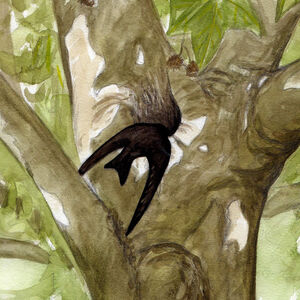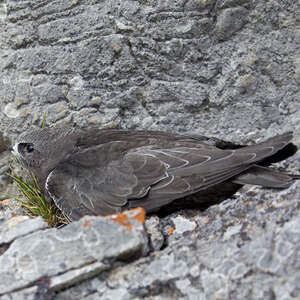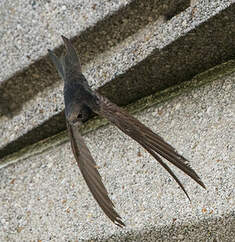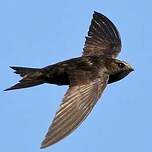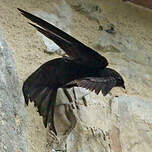Common Swift
Apus apus - Martinet noir
Identification
The Common Swift is recognizable in flight by its silhouette, its look and its dark plumage. The bird has a big head with a hunched neck, long scythe-like wings and a pointed tail. Its large size (wingspan of about 45 cm) is not always evident on the ground because of its slender silhouette. The wings have a very long and pointed hand, the second primary P2 (P9 for English) being the longest. The tail has 12 rectrices while all other swifts have 10. There is no sexual dimorphism. The plumage of the adult is generally sooty black with a lighter throat. At close and very good light, the underside of the body appears slightly mottled. The remiges and the rectrices have a glossy appearance which makes them appear lighter in underside view, especially when the ground reflects strong light. The juvenile has an even darker plumage, with a more contrasted white throat and lighter edgings, especially visible on the head taking on a frosted aspect, and on the front of the wing. Two sub-species are described, the eastern subspecies pekinensis having a more contrasted plumage and a lighter throat, but the difference is slight. The Common Swift could be confused with a swallow due to its long scythe-like wings and forked tail, but no swallow is as big, flies in the same way and, at least in Europe, has black undersides. The scythe-like wings are an adaptation to fast aerial displacements, developed by the two groups, systematically very distant, and constituting what is called a morphological convergence, resulting in a superficial resemblance. To the south of its breeding ground, it can mostly be confused with a close species, the Pallid Swift, whose plumage is a bit lighter, more brown, with a paler throat, but the difference can be subtle in bad light.Let's not speak of sub-Saharan Africa which holds a number of species of entirely dark Common Swifts.
Subspecific information 2 subspecies
- Apus apus apus (w Europe and n Africa to c Siberia)
- Apus apus pekinensis (n Iran to n China and Mongolia)
Foreign names
- Martinet noir,
- Vencejo común,
- andorinhão-preto,
- Mauersegler,
- sarlósfecske,
- Gierzwaluw,
- Rondone comune,
- tornseglare,
- Tårnseiler,
- dážďovník obyčajný,
- rorýs obecný,
- Mursejler,
- tervapääsky,
- Europese Windswael,
- falciot negre,
- Múrsvölungur,
- jerzyk (zwyczajny),
- svīre,
- hudournik,
- Чёрный стриж,
- ヨーロッパアマツバメ,
- 普通雨燕,
- 樓燕,
Voice song and call
The cry of the Common Swift is a high-pitched shrill trill. The bird is not stingy with it, especially during the typical aerial pursuits of the species. It also emits it at the nest, particularly when a noisy flock passes nearby. There is no song as such. The young at the nest emit a small begging crackle, which is also typical.
Habitat
The Common Swift's breeding habitat, the only one that can be precisely defined, is a type of rock habitat.
Behaviour character trait
The Common Swift, like all its relatives, is excellently adapted to the aerial environment it exploits skilfully. Its flight performances are extraordinary as we shall see later. It is a great migrator whose winter range is very far from its breeding range, thus carrying out very long migrations. In temperate climates, the return of the first migrants takes place around mid-April and continues until May. On the other hand, the departure at the end of summer is sudden and massive. By the end of July, once the juveniles have taken off, the great majority of swifts leave us. Some rare latecomers may still be seen at the end of August or in September, probably birds occupied with a late nest. The lifespan of the Common Swift is more than 20 years. What we mainly see of this bird in urban areas are the quick and noisy pursuits that they indulge in during the whole of the fine season around buildings. These are hard to miss out on, just like the reconnaissance flights of potential breeding sites under the roofs in accordance with an unchangeable scenario. The birds arrive with an ascending flight underneath the edge of a roof, pretend or actually land briefly while inspecting the area, take off again to come back right away.
Their manège can go on in a loop for a long time. It is the immature non-breeders who take part in such activities. Thus when they come back as adults the following year, they will probably already be paired, will have a perfect knowledge of the area and, notably, will know where to nest. As much as it is at ease when flying, it is awkward when landed. If a swift finds itself incidentally on the ground, for example after striking a wire, it finds it very difficult to take off again. Its very small legs and very large wings make it hard to take off.When not handicapped, it arrives on the bare ground, but in vegetation, it is impossible. Therefore, it must be taken by hand and thrown into the air for it to be able to fly. I have often done this without any issues with Common Swifts that have fallen into my attic or disused chimney, which I have ended up blocking off. The Common Swift's capacity for flight enables it to escape from unfavorable weather or climate conditions. This way, it can skirt around a very rainy depression or a storm zone in order to keep its ability to feed. At breeding sites, in case of prolonged bad weather, they are capable of entering a state of dormancy at the nest for several days while fasting. Their temperature decreases and they live in an energy-saving mode until favorable conditions return. It is the only group of birds to practice this kind of hibernation. Another extraordinary ability of this bird is its capability to sleep in flight without landing. One can easily observe the beginnings of this phenomenon during the beautiful summer evenings. One sees noisy Common Swift swarms rising progressively in the sky at nightfall until they are out of sight and hearing. Studies, thanks to radar among other tools, have shown that these birds remain at a high altitude, up to 2,000 meters, all night and descend again in the morning. It is assumed that they must sleep while gliding in rising hot air currents.Flight
The Common Swift's flight, like most swifts, is a direct and very fast flight, due to short but quick and energetic beats of its long, sickle shaped wings.
This flight is interrupted by frequent glides. It bears no resemblance to that of a swallow. The frequency of beating is so strong and the amplitude so weak that it appears the wings are vibrating. Because of their morphology and their way of beating, one could also think they beat alternatively and not simultaneously. In cruise flight, the speed is from 50 to 60 km/h, but the bird can rapidly accelerate and reach speeds over 100 km/h. In frantic chases, which are frequent in this species, speeds over 200 km/h have been reported, but for a very short lapse of time. On the other hand, the swift is capable of abrupt braking, for instance, when it arrives to the nest at high speed. One has the impression it is going to crash against the facade, but at the last moment it backs up while braking with all its feathers. Swifts also practice a lot of gliding which allows them energy savings. Finally, one can't conclude this chapter without discussing the permanent flight of swifts. These birds are physically and energetically tailored to remain in flight without landing for very long periods, several months for example. Thus, an adult Common Swift can, in theory, remain constantly in flight from August of one year to April of the following year, that is, from a reproduction period to another, which is simply phenomenal. The necessary rest would be taken during gliding in high altitude during the night.Dietfeeding habits
The Common Swift feeds on what is usually known as aerial plankton. Just like the waters contain organisms of different sizes living in its mass, the aerial environment contains a multitude of small animals during the summer, mainly flying insects, some of which are dragged away on sunny days by the winds and aerial currents to great heights.
Depending on the conditions, swifts can be seen hunting both at low heights above the waters or at the opposite, to great heights above the mountains. The sky is theirs. Their prey generally has less than one centimetre in length, and they mainly come from among the Diptera, the Hymenoptera and the Coleoptera. The Common Swift's widely cleft beak is an adaptation to the capture of insects, the beak itself being very small. As the average prey is small in size, the swift must hunt a lot to fulfill its own needs and those of the nest. When feeding the young, it stores the prey in its gullet, forming small balls. It has been calculated that each of them can contain up to 1 000 prey and that a bird's daily harvest can reach 20 000 items. To drink when it's very hot, the bird grazes the water surface with its beak while flying. In ordinary times, it just has to make do with the haemolymph of its prey and probably drops of rain.Reproduction nesting
The Common Swift is monogamous. Unless something unexpected happens, couples may be together for life as suggested by the observation of a couple occupying the same nest for ten consecutive years.
Nesting takes place in a confined space that the bird must be able to reach in flight. Most often, it is at the top of the wall supporting a building roof. It only needs a gap of 3-4 cm for the bird to slip through and access the space. It can then, if needed, crawl to the nest's location by using its short legs. The nest is made of any light material that the bird can gather on the fly without landing, such as feathers, wind-blown grass, spider web threads, pieces of paper, etc. Materials are placed in a flattened bowl shape on the substrate and glued together with saliva. The Common Swift lays between one and four eggs, usually two or three, which are white and oblong. Incubation, done by both adults, lasts about twenty days. Young's stay at the nest is a little more than 40 days. Their growth rate is dependent on the amount of food provided by the parents, which in turn greatly depends on weather conditions. In case of food shortages, they will slow down their growth until favorable conditions return. Flight takes place when they gain the capacity to fly and feed themselves. After this moment, the young cannot count on their parents anymore.Geographic range
Common Swift is an Eurasian species, present from the Atlantic Coast, including British and Irish islands, to the east of Mongolia, the northeast of China and Eastern Siberia. Its range reaches the Pacific coast in the South China Sea near Beijing. North of Beijing, it surpasses the polar circle up to Tromso and Murmansk, but it rarely ventures further into northern Siberia. The southern limit passes through the Maghreb, the Middle East, Iran and Pakistan. The 'apus' subspecies occupies Europe, northern Africa, and reaches east as far as Lake Baikal. From southeast Iran to Mongolia and northern China lies the subspecies 'pekinensis'. Its wintering area is entirely disconnected and located in Africa, especially south of the Equator, including for Asian birds.
Threats - protection
IUCN conservation status
concern
in the Wild
threatened
evaluated
The Common Swift is a common bird that is not currently threatened, although some localized declines have been noted. The main threat to breeding birds is the scarcity of potential nesting sites. Indeed, the renovation of buildings (facades and roofs) is a constant concern in an urban environment and unfortunately, it often deprives the swifts of the possibility of nesting. In general, birds are not taken into account in renovation projects. People are usually looking to prevent access to buildings for nuisances such as pigeons or jackdaws, thus depriving others, such as the Barn Owl, of the possibility of nesting. For swifts, people even don't consider it. But on a personal level, when I had my facades redone, I asked the contractor to leave holes under the roof so that the swifts could access their nests. He looked at me with big eyes. Obviously, it was a first for him.
Sources of information
- IOC World Bird List (v14.2), Gill, F and D Donsker (Eds). 2024-04-18.
- Swifts, Phil Chantler
- Les passereaux d'Europe, tome 1, P. Géroudet, M. Cuisin
- HBW Alive,
- Avibase, Lepage Denis
- xeno-canto, Sharing bird sounds from around the world,
Other sources of interest
 Specification sheet created on
11/07/2023 by Jean François
Specification sheet created on
11/07/2023 by Jean FrançoisTranslation by AI Oiseaux.net
© 1996-2025 Oiseaux.net
- Accipitriformes
- Aegotheliformes
- Anseriformes
- Apodiformes
- Apterygiformes
- Bucerotiformes
- Caprimulgiformes
- Cariamiformes
- Casuariiformes
- Charadriiformes
- Ciconiiformes
- Coliiformes
- Columbiformes
- Coraciiformes
- Cuculiformes
- Eurypygiformes
- Falconiformes
- Galliformes
- Gaviiformes
- Gruiformes
- Leptosomiformes
- Mesitornithiformes
- Musophagiformes
- Nyctibiiformes
- Opisthocomiformes
- Otidiformes
- Passeriformes
- Pelecaniformes
- Phaethontiformes
- Phoenicopteriformes
- Piciformes
- Podargiformes
- Podicipediformes
- Procellariiformes
- Psittaciformes
- Pterocliformes
- Rheiformes
- Sphenisciformes
- Steatornithiformes
- Strigiformes
- Struthioniformes
- Suliformes
- Tinamiformes
- Trogoniformes

